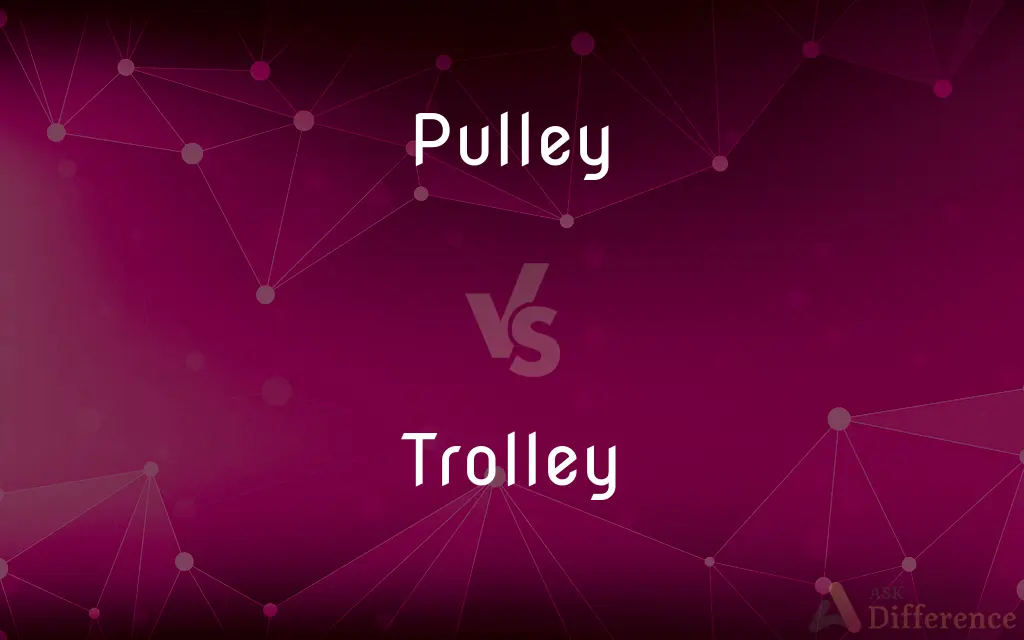Pulley vs. Trolley — What's the Difference?
By Fiza Rafique & Urooj Arif — Updated on May 2, 2024
Pulleys are wheel-based devices designed for lifting or moving loads using ropes, while trolleys are wheeled frameworks that travel on tracks to transport materials or passengers.

Difference Between Pulley and Trolley
Table of Contents
ADVERTISEMENT
Key Differences
Pulleys utilize a wheel and a rope to create a mechanical advantage, making it easier to lift heavy loads vertically. On the other hand, trolleys are equipped with wheels and often run on tracks, designed primarily for horizontal transportation.
The design of a pulley can vary from simple fixed pulleys to complex systems with multiple wheels, known as block and tackle, enhancing the lifting capability. In contrast, trolleys can be manual or powered by electricity or batteries, facilitating the movement of goods or people over longer distances.
Pulleys are integral to various machinery and lifting equipment, often used in construction and industrial settings. Whereas trolleys are commonly seen in manufacturing environments, warehouses, and public transportation systems like trams and airport shuttle services.
The operation of a pulley depends on the force applied to the rope and the number of wheels used, which affects the load-bearing capacity and the effort required. Trolleys, however, depend on their track system and propulsion method, whether manual, motorized, or gravity-based.
Safety considerations for pulleys include ensuring the rope is durable and properly secured, while for trolleys, maintaining the integrity of the track and the vehicle’s braking system is paramount.
ADVERTISEMENT
Comparison Chart
Primary Use
Lifting or moving loads upwards
Transporting horizontally
Mechanism
Wheel and rope
Wheels on tracks
Operation
Manual or mechanical
Manual, electric, or battery-powered
Common Settings
Industrial, construction
Warehouses, public transit
Safety Considerations
Rope durability, secure mounting
Track integrity, braking system
Compare with Definitions
Pulley
A simple machine consisting of a wheel over which a rope or chain is drawn in order to lift heavy objects.
They used a pulley to hoist the new air conditioning unit to the roof.
Trolley
Used extensively in public transportation systems like streetcars or trams.
They took the downtown trolley to reach the museum district.
Pulley
Part of a belt-driven system, especially in engines, to transmit power.
The mechanic replaced the worn-out pulley in the car's engine.
Trolley
Important in applications ranging from manufacturing to medical services.
In the hospital, nurses use trolleys to transport medical equipment and medications.
Pulley
A device that can change the direction of a force, often used in combination to gain mechanical advantage.
The engineers designed the system with multiple pulleys to reduce the labor needed.
Trolley
A wheeled vehicle designed to run on tracks for transporting goods or passengers.
The trolley at the airport made it easy to transport luggage from the terminal to the plane.
Pulley
Often made of materials like metal or heavy-duty plastic depending on its use.
Industrial pulleys are typically made from steel for added durability.
Trolley
Can refer to a mobile cart used in supermarkets or industries.
He pushed the trolley down the aisle, filling it with groceries.
Pulley
Used in various lifting applications from stagecraft to ship sails.
The stage crew used pulleys to adjust the heights of the backdrops.
Trolley
Electric trolleys are powered by overhead cables or batteries.
The city's electric trolley is a popular mode of eco-friendly transportation.
Pulley
A pulley is a wheel on an axle or shaft that is designed to support movement and change of direction of a taut cable or belt, or transfer of power between the shaft and cable or belt. In the case of a pulley supported by a frame or shell that does not transfer power to a shaft, but is used to guide the cable or exert a force, the supporting shell is called a block, and the pulley may be called a sheave.
Trolley
A large metal basket or frame on wheels, used for transporting heavy or large items, such as supermarket purchases or luggage at an airport or railway station.
Pulley
A wheel with a grooved rim around which a cord passes, which acts to change the direction of a force applied to the cord and is used to raise heavy weights.
Trolley
A wheel attached to a pole, used for collecting current from an overhead electric wire to drive a tram.
Pulley
Hoist with a pulley
The tree house was built on the ground and pulleyed into the branches
Trolley
Short for trolleybus or trolley car
Pulley
A simple machine consisting essentially of a wheel with a grooved rim in which a pulled rope or chain can run to change the direction of the pull, for example to lift a load.
Trolley
A streetcar.
Pulley
A wheel turned by or driving a belt.
Trolley
A device that collects electric current from an underground conductor, an overhead wire, or a third rail and transmits it to the motor of an electric vehicle.
Pulley
One of the simple machines; a sheave, a wheel with a grooved rim, in which a pulled rope or chain lifts an object (more useful when two or more pulleys are used together, as in a block and tackle arrangement, such that a small force moving through a greater distance can exert a larger force through a smaller distance).
Trolley
A small truck or car operating on a track and used in a mine, quarry, or factory for conveying materials.
Pulley
(transitive) To raise or lift by means of a pulley.
Trolley
A wheeled carriage, cage, or basket that is suspended from and travels on an overhead track.
Pulley
A wheel with a broad rim, or grooved rim, for transmitting power from, or imparting power to, the different parts of machinery, or for changing the direction of motion, by means of a belt, cord, rope, or chain.
Trolley
Chiefly British A light cart designed to be moved by hand.
Pulley
To raise or lift by means of a pulley.
Trolley
To convey (passengers) or travel by trolley.
Pulley
A simple machine consisting of a wheel with a groove in which a rope can run to change the direction or point of application of a force applied to the rope
Trolley
A trolley pole; a single-pole device for collecting electrical current from an overhead electrical line, normally for a tram/streetcar or a trolleybus.
Trolley
(US) A streetcar or light train.
Trolley
A light rail, tramway, trolleybus or streetcar system.
Trolley
A truck from which the load is suspended in some kinds of cranes.
Trolley
A truck which travels along the fixed conductors in an electric railway, and forms a means of connection between them and a railway car.
Trolley
A cart or shopping cart; a shopping trolley.
Trolley
(British) A hand truck.
Trolley
(British) A soapbox car.
Trolley
(British) A gurney, a stretcher with wheeled legs.
Trolley
(Philippines) A handcar.
Trolley
To bring to by trolley.
Trolley
To use a trolley vehicle to go from one place to another.
Trolley
To travel by trolley (streetcar, trolleybus or light train).
Trolley
A form of truck which can be tilted, for carrying railroad materials, or the like.
Trolley
A wheeled vehicle that runs on rails and is propelled by electricity;
`tram' and `tramcar' are British terms
Common Curiosities
What types of trolleys are there?
There are manual, electric, and battery-powered trolleys, each suited to different environments like factories, hospitals, or public transit.
Where are pulleys most commonly used?
Pulleys are commonly used in construction, industrial settings, and any situation requiring lifting.
What is the difference between a trolley and a tram?
A trolley generally refers to a lighter, more versatile vehicle for goods or small-scale passenger transport, while a tram is specifically designed for public transportation on urban tracks.
What is the basic function of a pulley?
A pulley is used to lift or move loads by changing the direction of force applied through a rope.
How does a trolley work?
A trolley works by moving along a track, which can be powered manually or by electricity.
Can pulleys be used to move objects horizontally?
While primarily for vertical lifting, pulleys can be configured in systems to aid horizontal movement in certain setups.
What materials are pulleys made from?
Pulleys are often made from materials like steel, aluminum, or heavy-duty plastics, depending on their specific application.
What maintenance does a trolley require?
Regular maintenance on a trolley includes checking the wheels, tracks, and power systems to ensure safe operation.
Are trolleys safe for transporting people?
Yes, trolleys designed for passenger transport are equipped with safety features like brakes and are subject to stringent regulations.
How do pulleys provide a mechanical advantage?
Pulleys reduce the amount of force needed to lift a load, effectively multiplying the force applied through the rope.
Is a pulley considered a machine?
Yes, a pulley is considered a simple machine as it allows the user to gain a mechanical advantage.
How do electric trolleys receive power?
Electric trolleys typically receive power via overhead cables or embedded tracks with electrical conductors.
Can trolleys be used without tracks?
Generally, trolleys are designed to operate on tracks, but some specialized versions may be adapted for off-track use.
How does the complexity of a pulley system affect its function?
More complex pulley systems, like block and tackle arrangements, allow for greater load lifting with less force, but require careful setup and maintenance.
Are there any innovative uses of pulleys in modern technology?
Pulleys are used in modern applications ranging from theater stage mechanisms to advanced material handling systems in industries.
Share Your Discovery

Previous Comparison
Reevaluate vs. Revaluate
Next Comparison
Gene vs. CistronAuthor Spotlight
Written by
Fiza RafiqueFiza Rafique is a skilled content writer at AskDifference.com, where she meticulously refines and enhances written pieces. Drawing from her vast editorial expertise, Fiza ensures clarity, accuracy, and precision in every article. Passionate about language, she continually seeks to elevate the quality of content for readers worldwide.
Co-written by
Urooj ArifUrooj is a skilled content writer at Ask Difference, known for her exceptional ability to simplify complex topics into engaging and informative content. With a passion for research and a flair for clear, concise writing, she consistently delivers articles that resonate with our diverse audience.













































